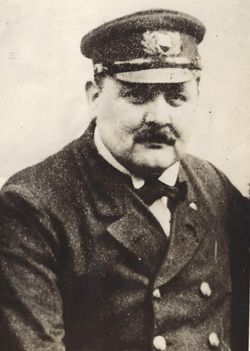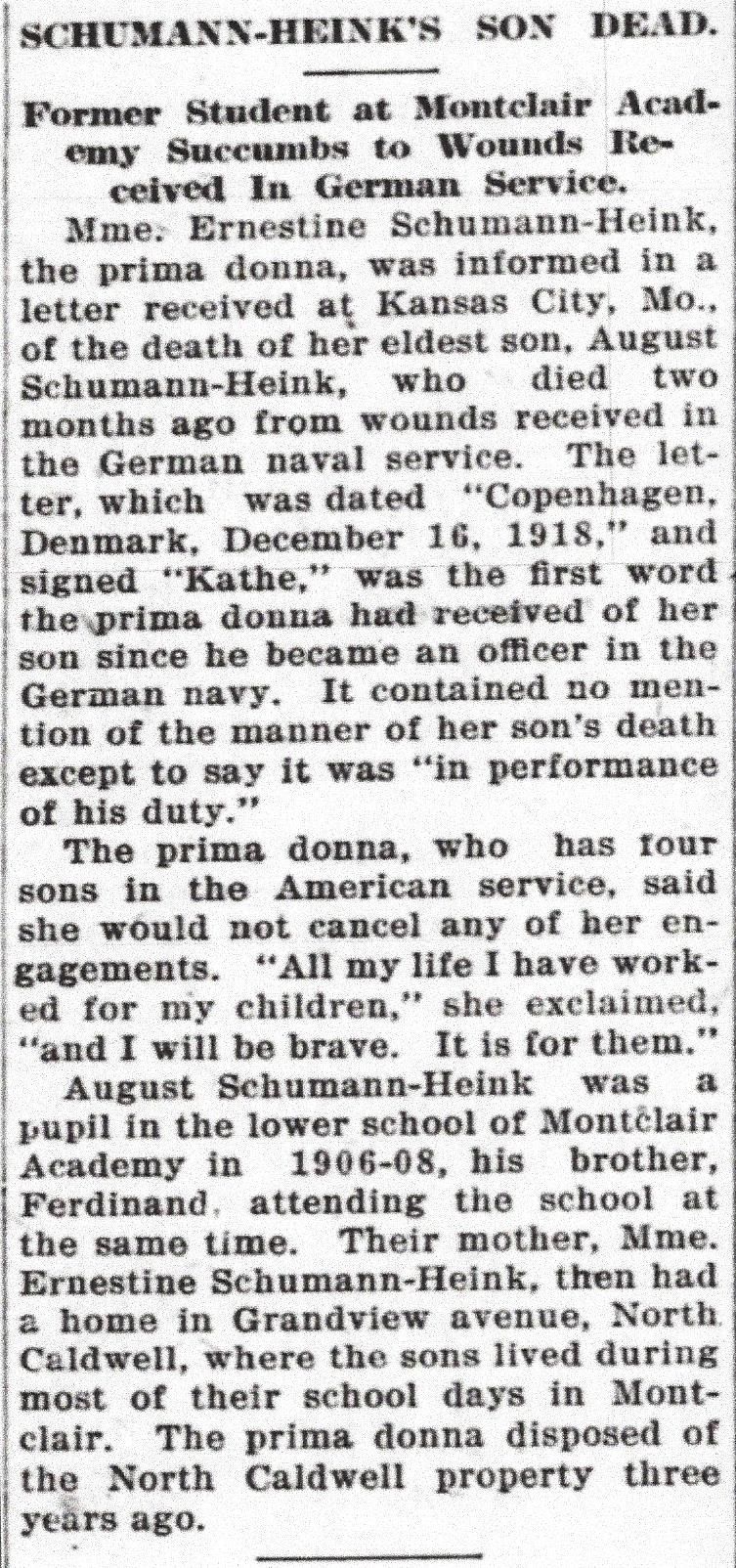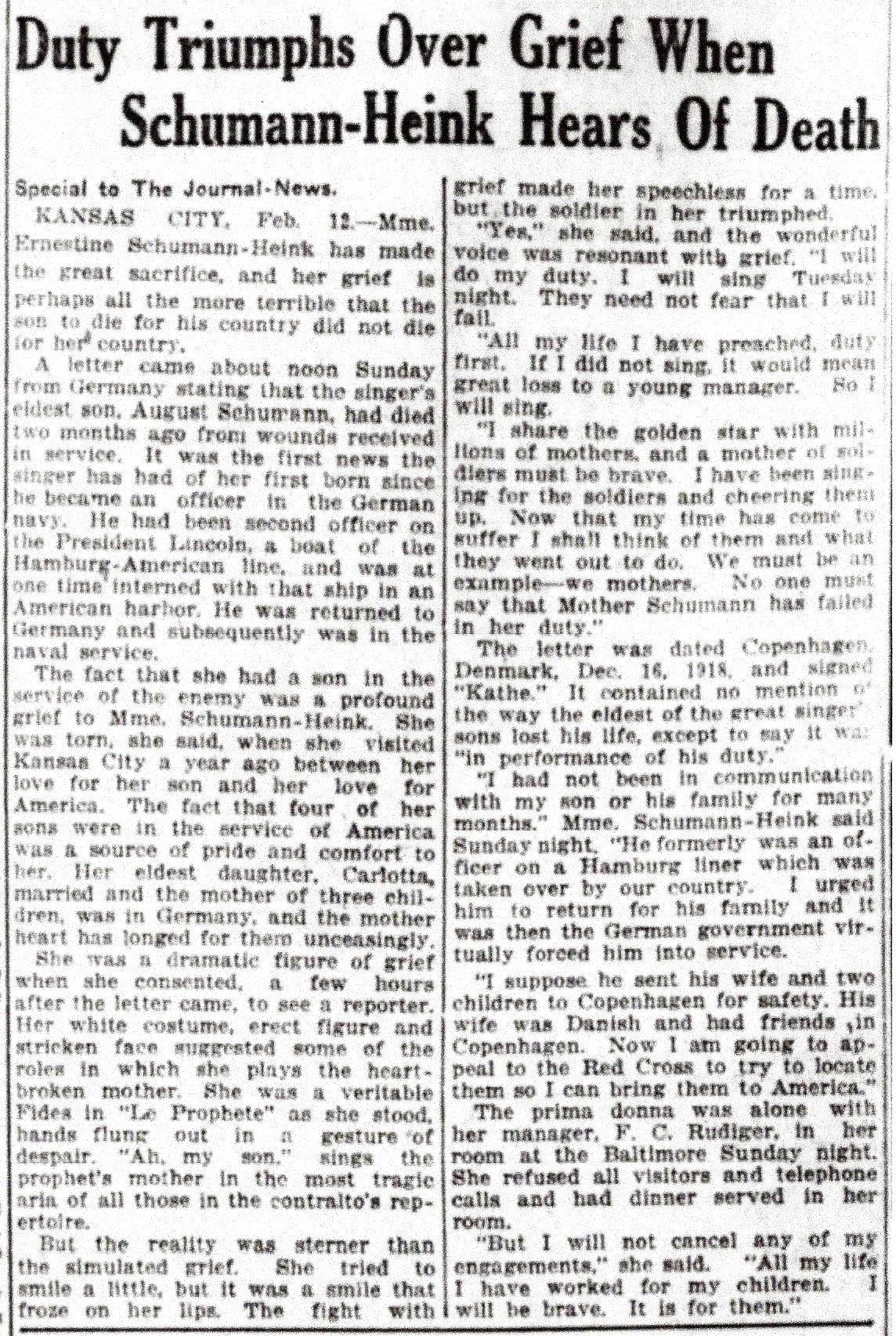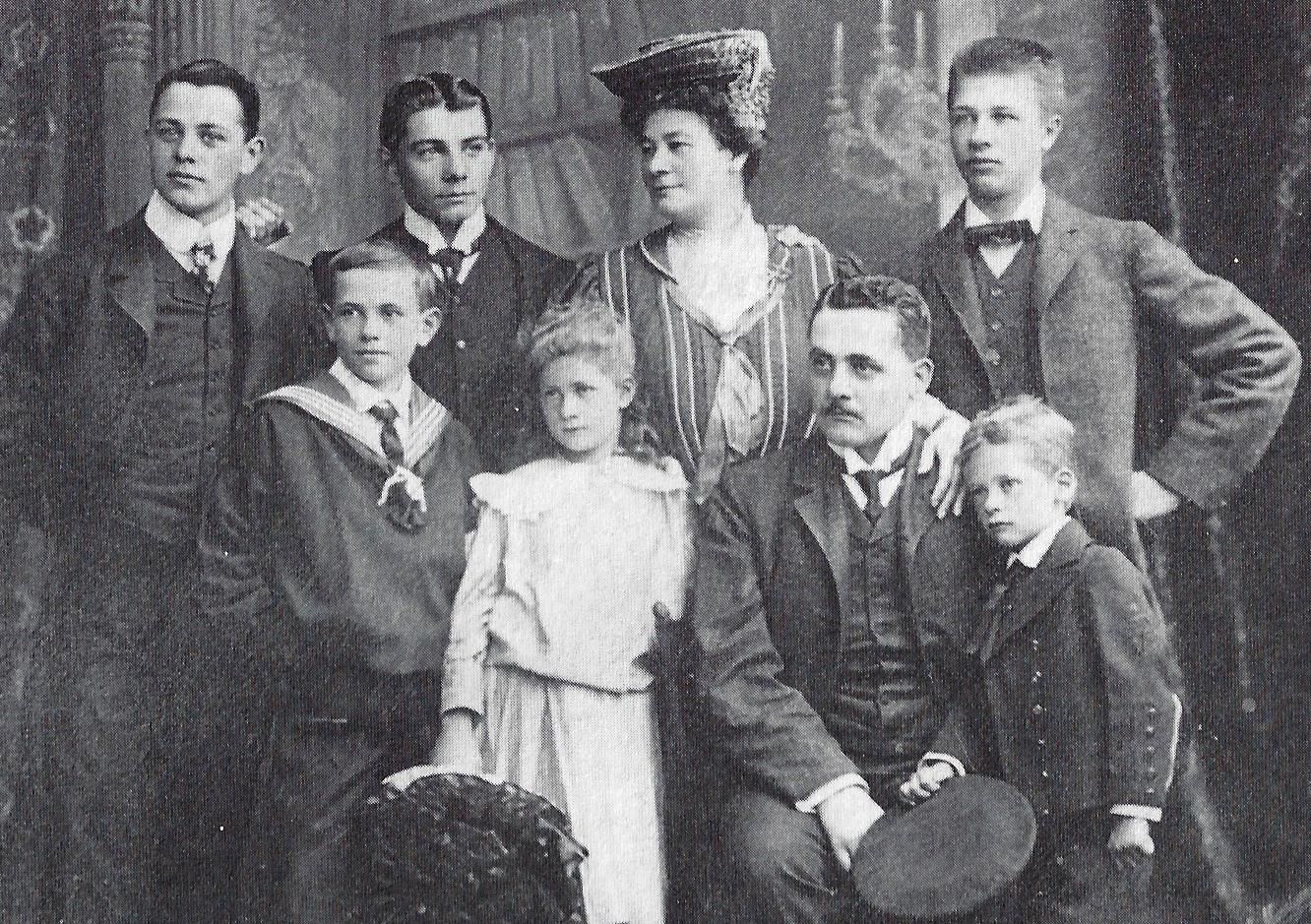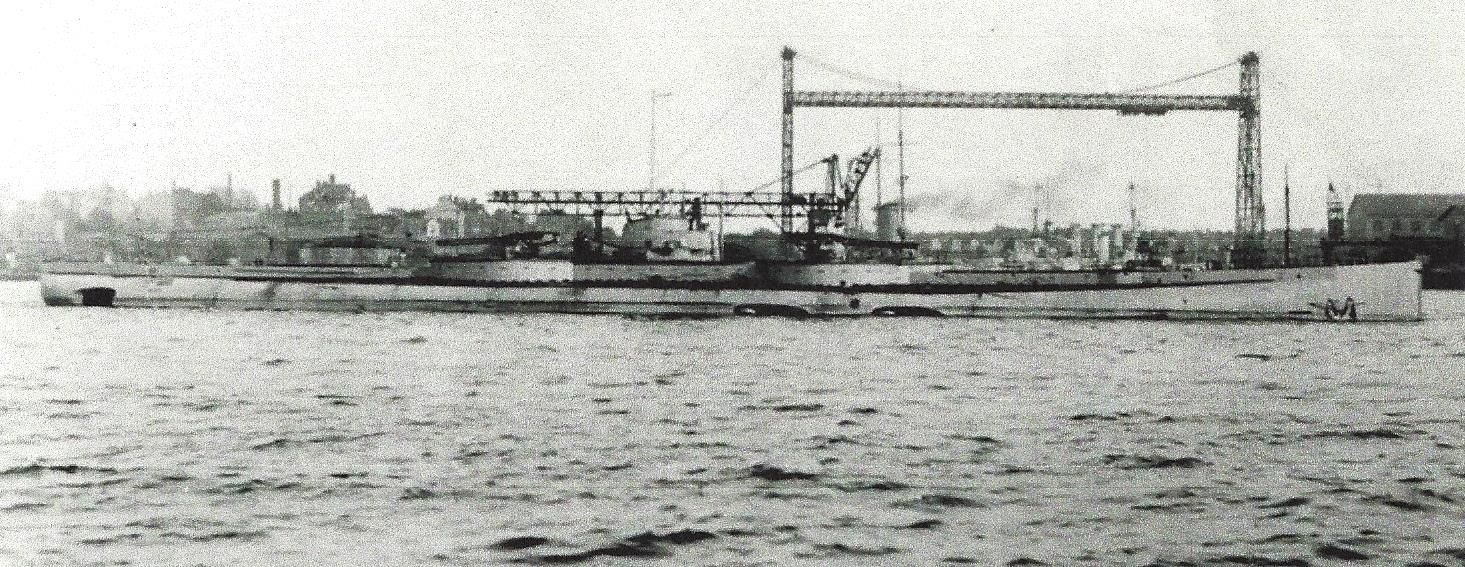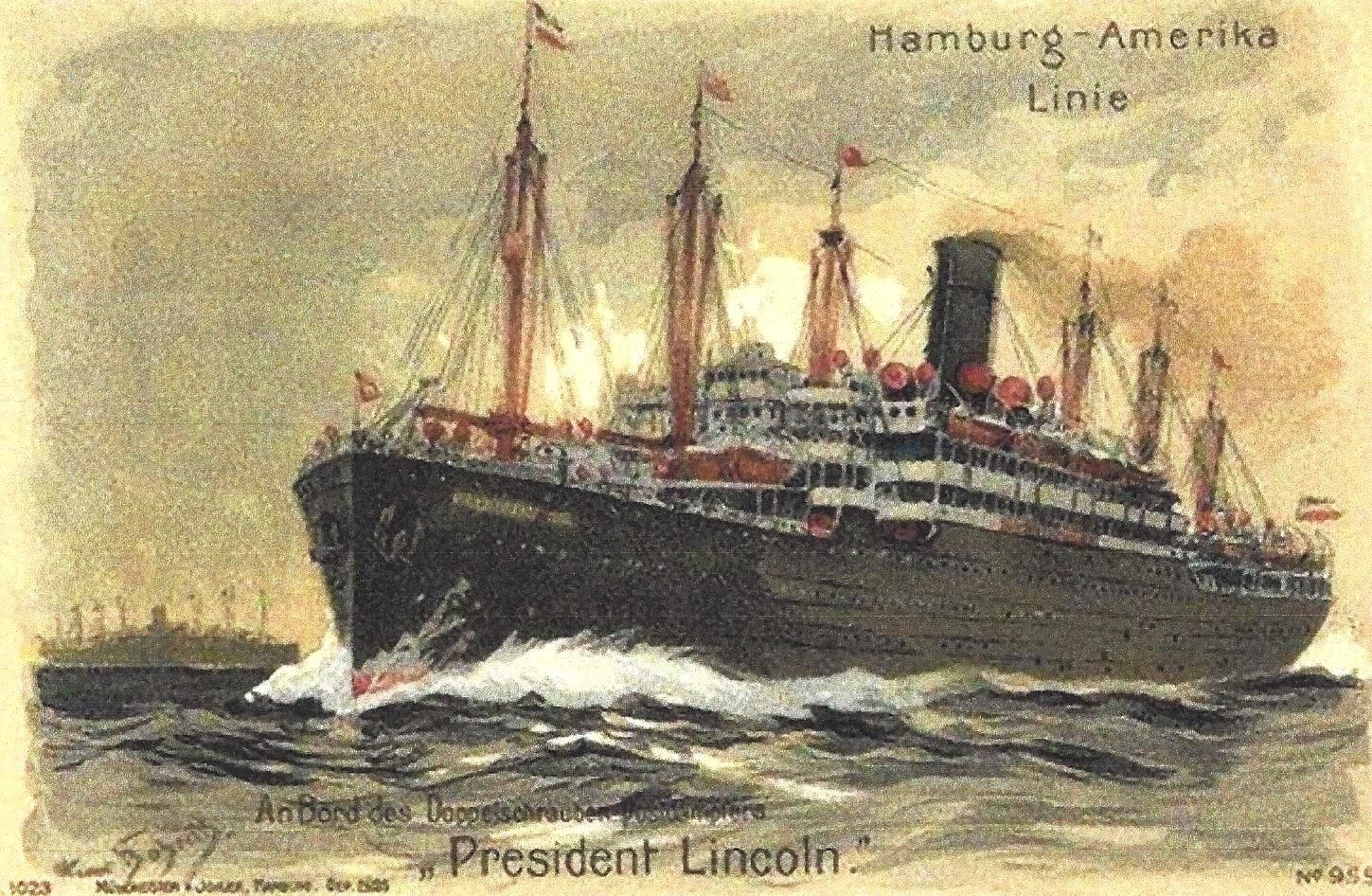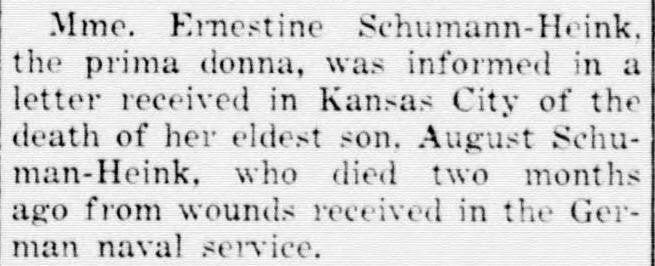Known by his family name as August, he was the oldest child of Mme. Ernestine Schumann-Heink and her first husband, Johann Georg Ernst Albert Heink. Due to his mother's continued absences during her performance career in the 1880's and 90's, August left home as a teenager and received most of his education while serving in the German merchant marine.
August remained in Germany when his mother started performing in the United States. Although he made several trips to the USA to visit her, he never considered living in America on a permanent basis. He married Käthe Finsen in Germany on 3 July 1905 and made an initial trip to the USA in 1907.
Prior to the beginning of WWI in Europe, he served in the German merchant marine as the second officer (navigation officer) on the passenger liner "President Lincoln" of the Hamburg-Amerika Line. This ship was interned upon its arrival in NYC on 5 August 1914 and then docked at Hoboken, NJ until April 1917, when it was formally seized upon the formal entry of the USA into WWI. It was later used as a troop transport ship conveying soldiers to France before it was sunk in 1918.
After his ship was seized, August visited his mother in Chicago and lived at her home in San Diego with her until mid-1915. Technically, he was interned in the USA as an alien non-combatant and was prohibited by international convention from participating in the hostilities. But he worked his way back to Germany on a neutral freighter and joined the Imperial German Navy, where his skills as a navigator were needed as part of the war effort. Some accounts say he enlisted eagerly; others say it was under duress. In an unpublished biography of his grandmother, August's son Hans said that before his return to Germany, August said repeatedly to his mother, "My Kaiser, my country, my family." Clearly, his loyalties during WWI were with Germany and not the United States, the adopted country of his mother.
Newspaper accounts from June 1915 (the last ones mentioning his time in the USA) show that he was present at El Cajon for the marriage of his brother, Ferdinand, to Margaret M. McCann. Shortly after, his mother saw him off on the train, bound for New York, but this was the last time she saw her oldest son.
American newspaper accounts in the early years of the war indicated he was the commander of the German U-52, and although he may have served aboard that submarine, the list of its commanders during WWI does not include his name. According to other accounts (by his mother), he was awarded two Iron Crosses from Germany and an Austrian medal for his role in mine-laying off the coast of Italy, but no confirmed record of those awards has been found.
At the time of his death, he was the Obersteuermann, the chief navigator and senior-ranking NCO of the U-156. Typically, men of this rank were the oldest and most experienced crewmen. It's not known if August was a crew member of this submarine on its first voyage in 1917, but on its second one, to the East Coast of the United States, crew members with knowledge of the East Coast, the approaches to the New York harbor, and the shores of Long Island were specially recruited for service in the U-boat campaign in the Western Atlantic against the United States.
The U-156 sailed from Kiel, Germany on 15 June 1918 on her second and final mission, passed through the North Sea around the northern tip of the British Isles, and set sail for Long Island, NY and the New York harbor, where she had been ordered to lay mines in the shipping lanes near the harbor and along the south shore of Long Island.
The U-156 laid the mines that sank the USS San Diego (formerly the USS California), the largest warship lost by the United States in naval action during WWI. The remains of that ship lie near Fire Island.
On 21 July 1918 the U-156 opened fire on a beach and marsh area offshore of Orleans, MA while pursuing American merchant vessels. The U-156 severely damaged a tugboat and sank four barges. The attack on Orleans was the only Central Powers raid mounted directly against the mainland of the USA during WWI and the first time the continental USA had been shelled by a foreign power since the Siege of Fort Texas during the Mexican American War in 1846.
After sinking or severely damaging at least 36 naval and merchant ships of the United States and Canada along the East Coast during its second mission, the submarine began her return journey to Kiel in early September but was sunk by a mine in the North Sea Mine Barrage Area located between the Orkney Islands and the west coast of Norway. All 77 crew members were lost. The ship rests at Latitude 59° 44' 15" North and Longitude 01° 56' 00" East at an approximate depth of 300 feet. To date, no dive team efforts have located the remains of the wreck in this area of the North Sea.
[Contrary to some earlier reports, August did not die on 15 June 1918 and his death did not occur from the ramming of his submarine by an American destroyer in the English Channel or off the coast of France. Later naval intelligence has confirmed the date and location of the U-156's loss in the North Sea and his presence on the submarine.]
Three of August's brothers served in the US Navy during WWI; another served earlier in the US Army but died in 1916 before the United States entered the war.
In 1919, his mother, Mme. Ernestine Schumann-Heink, brought August's widow Käthe and his two children, Ilse and Hans, to the USA to live with her in California.
********************************************************************************
Die U 156 ist "am 25.09.1918 in der nördlichen Nordsee verschollen." 77 Tote, keine Überlebende.
[The U-156 is lost on 25 September 1918 in the North Sea passage. 77 dead, no survivors.]
Wahrscheinlich durch Mine versenkt. Das Boot hat sich nach der Durchfahrt der nördlichen Passage nicht mehr gemeldet.
[Probably sunk by a mine. The boat did not report after passing through the northern passage.]
http://uboat.net/wwi/boats/index.html
Contributor: AenneLa (48548982) • [email protected]
Known by his family name as August, he was the oldest child of Mme. Ernestine Schumann-Heink and her first husband, Johann Georg Ernst Albert Heink. Due to his mother's continued absences during her performance career in the 1880's and 90's, August left home as a teenager and received most of his education while serving in the German merchant marine.
August remained in Germany when his mother started performing in the United States. Although he made several trips to the USA to visit her, he never considered living in America on a permanent basis. He married Käthe Finsen in Germany on 3 July 1905 and made an initial trip to the USA in 1907.
Prior to the beginning of WWI in Europe, he served in the German merchant marine as the second officer (navigation officer) on the passenger liner "President Lincoln" of the Hamburg-Amerika Line. This ship was interned upon its arrival in NYC on 5 August 1914 and then docked at Hoboken, NJ until April 1917, when it was formally seized upon the formal entry of the USA into WWI. It was later used as a troop transport ship conveying soldiers to France before it was sunk in 1918.
After his ship was seized, August visited his mother in Chicago and lived at her home in San Diego with her until mid-1915. Technically, he was interned in the USA as an alien non-combatant and was prohibited by international convention from participating in the hostilities. But he worked his way back to Germany on a neutral freighter and joined the Imperial German Navy, where his skills as a navigator were needed as part of the war effort. Some accounts say he enlisted eagerly; others say it was under duress. In an unpublished biography of his grandmother, August's son Hans said that before his return to Germany, August said repeatedly to his mother, "My Kaiser, my country, my family." Clearly, his loyalties during WWI were with Germany and not the United States, the adopted country of his mother.
Newspaper accounts from June 1915 (the last ones mentioning his time in the USA) show that he was present at El Cajon for the marriage of his brother, Ferdinand, to Margaret M. McCann. Shortly after, his mother saw him off on the train, bound for New York, but this was the last time she saw her oldest son.
American newspaper accounts in the early years of the war indicated he was the commander of the German U-52, and although he may have served aboard that submarine, the list of its commanders during WWI does not include his name. According to other accounts (by his mother), he was awarded two Iron Crosses from Germany and an Austrian medal for his role in mine-laying off the coast of Italy, but no confirmed record of those awards has been found.
At the time of his death, he was the Obersteuermann, the chief navigator and senior-ranking NCO of the U-156. Typically, men of this rank were the oldest and most experienced crewmen. It's not known if August was a crew member of this submarine on its first voyage in 1917, but on its second one, to the East Coast of the United States, crew members with knowledge of the East Coast, the approaches to the New York harbor, and the shores of Long Island were specially recruited for service in the U-boat campaign in the Western Atlantic against the United States.
The U-156 sailed from Kiel, Germany on 15 June 1918 on her second and final mission, passed through the North Sea around the northern tip of the British Isles, and set sail for Long Island, NY and the New York harbor, where she had been ordered to lay mines in the shipping lanes near the harbor and along the south shore of Long Island.
The U-156 laid the mines that sank the USS San Diego (formerly the USS California), the largest warship lost by the United States in naval action during WWI. The remains of that ship lie near Fire Island.
On 21 July 1918 the U-156 opened fire on a beach and marsh area offshore of Orleans, MA while pursuing American merchant vessels. The U-156 severely damaged a tugboat and sank four barges. The attack on Orleans was the only Central Powers raid mounted directly against the mainland of the USA during WWI and the first time the continental USA had been shelled by a foreign power since the Siege of Fort Texas during the Mexican American War in 1846.
After sinking or severely damaging at least 36 naval and merchant ships of the United States and Canada along the East Coast during its second mission, the submarine began her return journey to Kiel in early September but was sunk by a mine in the North Sea Mine Barrage Area located between the Orkney Islands and the west coast of Norway. All 77 crew members were lost. The ship rests at Latitude 59° 44' 15" North and Longitude 01° 56' 00" East at an approximate depth of 300 feet. To date, no dive team efforts have located the remains of the wreck in this area of the North Sea.
[Contrary to some earlier reports, August did not die on 15 June 1918 and his death did not occur from the ramming of his submarine by an American destroyer in the English Channel or off the coast of France. Later naval intelligence has confirmed the date and location of the U-156's loss in the North Sea and his presence on the submarine.]
Three of August's brothers served in the US Navy during WWI; another served earlier in the US Army but died in 1916 before the United States entered the war.
In 1919, his mother, Mme. Ernestine Schumann-Heink, brought August's widow Käthe and his two children, Ilse and Hans, to the USA to live with her in California.
********************************************************************************
Die U 156 ist "am 25.09.1918 in der nördlichen Nordsee verschollen." 77 Tote, keine Überlebende.
[The U-156 is lost on 25 September 1918 in the North Sea passage. 77 dead, no survivors.]
Wahrscheinlich durch Mine versenkt. Das Boot hat sich nach der Durchfahrt der nördlichen Passage nicht mehr gemeldet.
[Probably sunk by a mine. The boat did not report after passing through the northern passage.]
http://uboat.net/wwi/boats/index.html
Contributor: AenneLa (48548982) • [email protected]
Inscription
U156
Gravesite Details
Died from wounds received (possibly drowning) in the sinking of his submarine, the U-156, in the North Sea Mine Barrage Area in September 1918
Family Members
Sponsored by Ancestry
Advertisement
Advertisement
